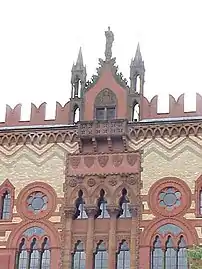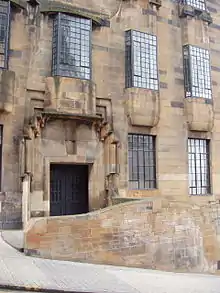Architecture of Glasgow
The city of Glasgow, Scotland is particularly noted for its 19th-century Victorian architecture, and the early-20th-century "Glasgow Style", as developed by Charles Rennie Mackintosh.

Very little of medieval Glasgow remains, the two main landmarks from this period being the 15th-century Provand's Lordship and 12th-century St. Mungo's Cathedral. St. Mungo's Cathedral, also known as the High Kirk and Glasgow Cathedral, is the oldest building in Glasgow and is an example of Scottish Gothic architecture.
The vast majority of the city as seen today dates from the 19th century. As a result, Glasgow has a heritage of Victorian architecture: the Glasgow City Chambers; the main building of the University of Glasgow, designed by Sir George Gilbert Scott; and the Kelvingrove Art Gallery and Museum, designed by Sir John W. Simpson are examples.
Glasgow Style

The city is notable for architecture designed by Charles Rennie Mackintosh (1868–1928). Mackintosh was an architect and designer in the Arts and Crafts movement and the main exponent of Art Nouveau in the United Kingdom, designing Glasgow buildings such as the Glasgow School of Art, Willow Tearooms and the Scotland Street School. Also designed by Mackintosh is the Queen's Cross Church, the only church by the artist to be built.[1]
Victorian era

Another architect who had an impact on the city's appearance was Alexander Thomson (1817–1875). Thomson produced a style of architecture based on fundamentalist classicism that gave him the nickname "Greek". Examples of Thomson's work can be found over the city,[2] with notable examples including the Holmwood House villa and St. Vincent Street Church.
The buildings reflect the wealth and self-confidence of the residents of the "Second City of the Empire". Glasgow generated wealth from trade and the industries that developed from the Industrial Revolution. The Templeton's carpet factory on Glasgow Green was designed to resemble the Doge's Palace in Venice and epitomises Glaswegians' desire to demonstrate architectural opulence during this era.[3]

Many of the city's buildings were built with red or blond sandstone, but during the industrial era those colours disappeared under a pervasive black layer of soot and pollutants from the furnaces, until the Clean Air Act was introduced in 1956. In recent years many of these buildings have been cleaned and restored to their original appearance.
Ecclesiastical architecture
Many important historicist churches were built in Victorian Glasgow, including the St. Vincent Street Church and the Romanesque Revival Garnethill Synagogue.
Modern era
Modern buildings in Glasgow include the Glasgow Royal Concert Hall, and along the banks of the Clyde are the Glasgow Science Centre and the Scottish Exhibition and Conference Centre, whose Clyde Auditorium was designed by Sir Norman Foster, and is known as the "Armadillo". Zaha Hadid won a competition to design the new Riverside Museum to house the Glasgow Museum of Transport[4]
Glasgow's historical and modern architectural traditions were celebrated in 1999 when the city was designated UK City of Architecture and Design,[5] winning the accolade over Liverpool and Edinburgh.[6]
References
- Watch video of the church Archived 5 June 2009 at the Wayback Machine and Interview with Stuart Robertson, Charles Rennie Mackintosh Society Director
- Thomson Buildings
- "Templeton's Carpet Factory, Glasgow - Princes Regeneration". Archived from the original on 19 October 2007. Retrieved 17 December 2008.
- "Museum of Transport Glasgow". Glasgow Architecture. Archived from the original on 22 December 2007. Retrieved 13 December 2007.
- Glasgow: Scotland with style - City of Reinvention By Nancy McLardie Archived 2010-01-13 at the Wayback Machine
- Glasgow City Council: Regeneration - into the new Millennium Archived 26 May 2009 at the Wayback Machine
